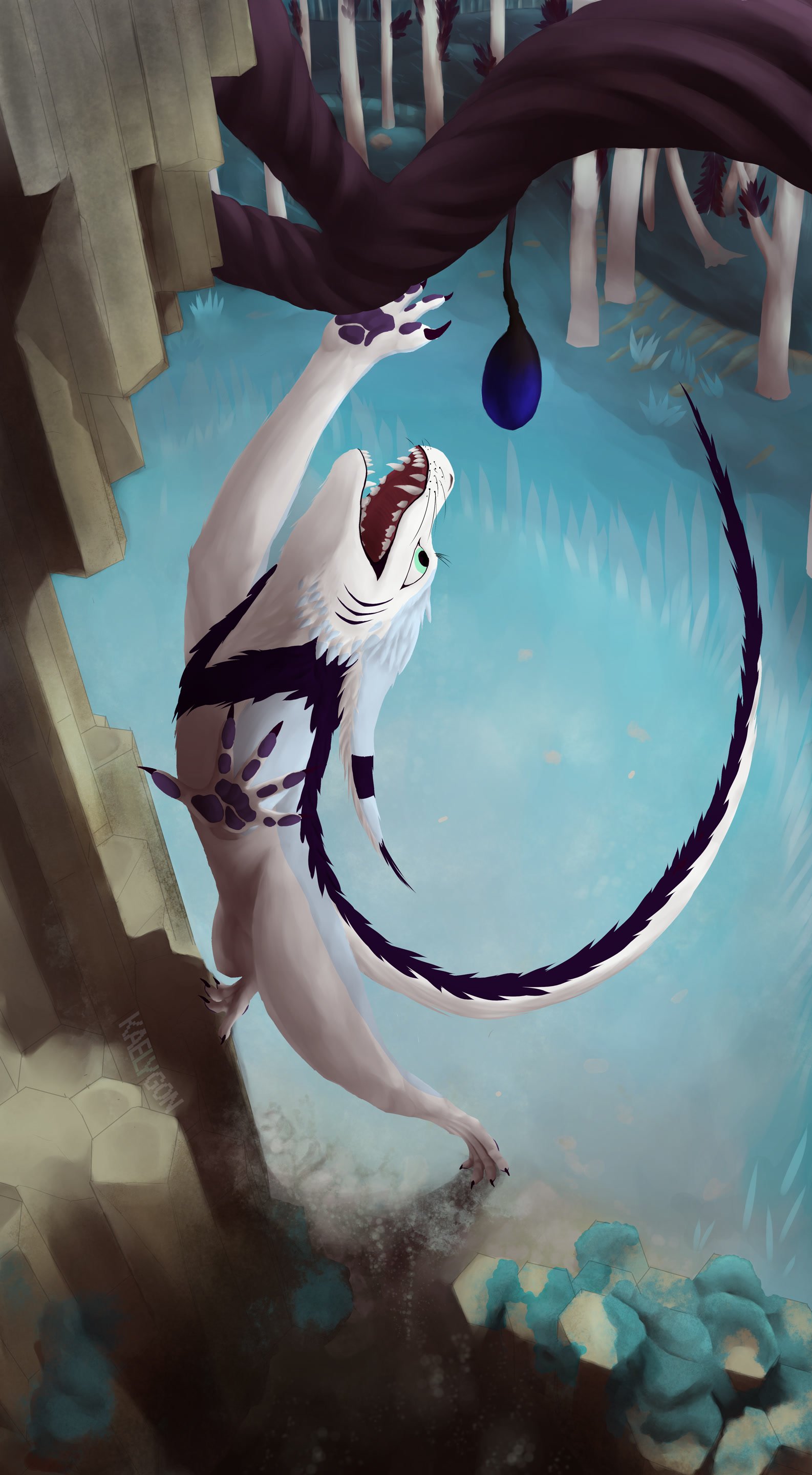License: CC0 1.0 Universal Kaelygon 2024
Lacertocyon plumocrista (feather crested lizard dog), also known as feather maned dragon or simply maned dragon. Despite the name and similarities to reptiles and canids, Lacertocyon belongs to an entirely different family, Lacertherids, that diverged from late Eutherians.
- Kingdom: Animalia
- Phylum: Chordata
- Class: Mammalia
- Order: Lacertheriformes
- Family: Lacertheridae
- Genus: Lacertocyon
- Species: plumocrista
Average size: 100 cm at withers, weight 45 kg Speed: Up to 50 km/h in short sprint
Traits
- Warm-blooded, Placental Mammal, Predator, Omnivore, Venomous
Appearance
- Maned dragons are covered in thin fur, and they have a feathered mane that reaches from their head down to the tip of the tail. The mane consists of feather-like keratinous strands evolved from fur.
- This mane can puff up to appear bigger when threatened and acts as a protection and in heat regulation on cold nights.
- Maned dragons have long ears with tufts at the end.
- Their color is a mix of yellows, browns, and greens with lighter countershading. Colorization can also vary depending on the region.
- Maned dragon's teeth resemble those of canines or raccoons, which are suitable for an omnivorous diet.
- Their whiskers are as wide as their body front profile. When traversing narrow pathways, these whiskers would indicate when the gap is too narrow to fit.
- They have five 3-segmented fingers and four 2-segmented toes, which are closer to reptilian hands than canine paws by appearance.
- Skull shape is similar to reptiles, with external nares positioned like crocodiles. It lacks a rhinarium, but smell receptors are still located in the nasal cavity. The nasal cavity is still wet to help with smell
- Maned dragons have long digitigrade legs to be able to see in tall foliage. Making their gait akin to Maned Wolves.
- The similarities to canines and reptiles are largely superficial. These features evolved convergently to compete with modern carnivora.
Behavior
- Maned dragons are diurnal. They have trichromatic color vision, which is more advantageous in foraging, but this comes at the cost of poorer night vision.
- Their habitat is dry tropical forest and semiarid desert, and they are most active around temperatures of 10-25C.
- Maned dragons may share overlapping territories. Despite this, they are rarely aggressive against others unless food is scarce.
- The species is a solitary hunter and can hunt up to 60 kg, but their preferred prey weighs 20-40 kg.
- Maned dragons are omnivorous and often forage and eat various vegetable matter.
- When food is scarce, they can resort to scavenging. Their stomach acid is strong enough to digest bones.
- Any indigestible material, such as fur or large fragments, is regurgitated in compacted pellets.
- Maned dragons communicate via howls and barks or roars like Maned wolves. When they are threatened, they make hissing or growling sounds.
Reproductive organs
- The reproductive organs of maned dragons are similar to those of some aquatic mammals, such as cetaceans, with a few differences.
- Unlike cetaceans, L. plumocrista's anus is located outside the mammary slit before the root of the tail.
- Both male's and female's sexual organs are internal, resulting in a visually flush underside.
- In males, the penis and testes are internal, with the penis extending during mating.
- The species has six teats similar to canines, which are hidden under the fur and become only pronounced in nursing females.
- Outside reproductive organs, the species has very little sexual dimorphism.
Reproduction
- The female gives live birth and nurses a litter of 2 to 6 young with a gestation a period of 3-4 months.
- During this period, the male may share the territory and assist with raising the offspring by hunting and providing protection. They don't necessarily share the same living space until at late stage of the gestation. While the species is mostly solitary, they form some relations between individuals.
Venom
- Maned dragon has venom glands in the lower jaw. Some of the bottom teeth have grooves for the venom.
- Venom is useful when prey is too large to be disabled quickly by teeth and claws alone.
- If the prey becomes troublesome to kill, L. plumocrista may stalk the prey until the venom takes effect.
- The venom may also be used in defense, as it induces intense pain to repel the attacker.
The maned dragon would likely have evolved a unique venom composition with effects similar to these components:
- Intense pain: Bradykinin, Capsaicin
- Muscle paralysis: Dendrotoxin, Fasciculins, Conotoxins
- Venom spread promoters: Phospholipases, Metalloproteinases, Vasodilator
Evolution
- Lacertheriformes diverged from Eutherians some time before carnivora and convergently evolved alongside them, developing a unique set of traits.
- Amniota -> Cynodontia (259 mya) -> Eutheria (145 mya) -> Palutherium (100-66 mya) -> Palusaurictis (66 mya) -> Lacertocyon (34 mya)
Edit2: further updates at https://github.com/Kaelygon/Lacertocyon-plumocrista
